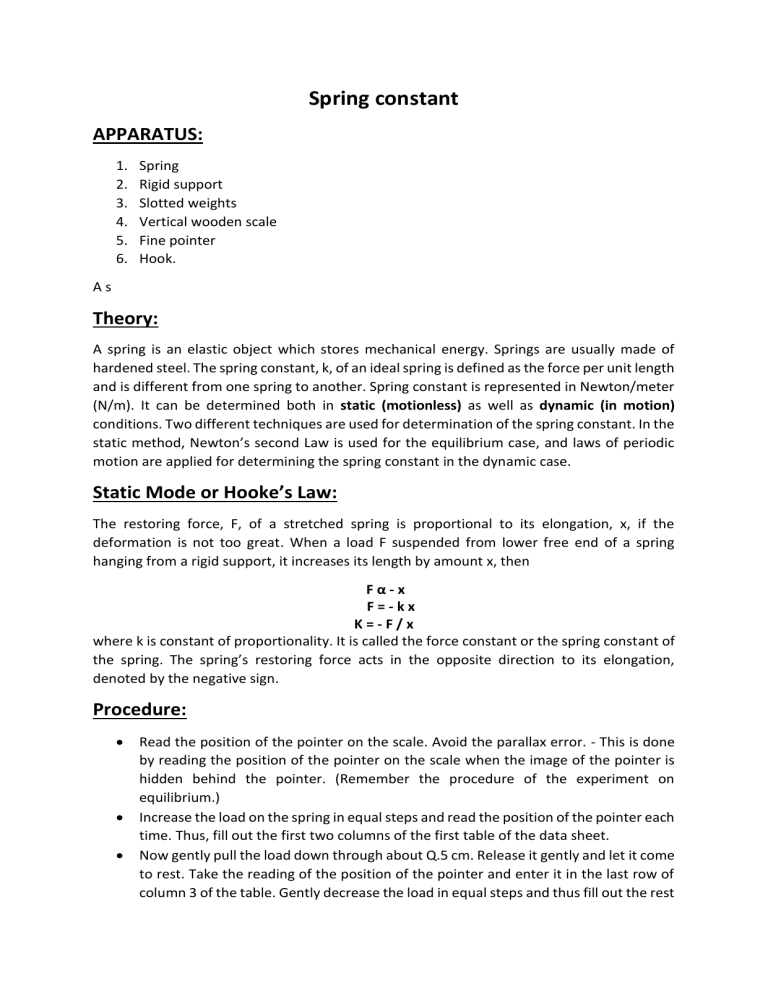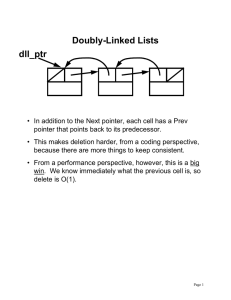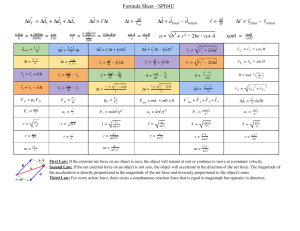
Spring constant APPARATUS: 1. 2. 3. 4. 5. 6. Spring Rigid support Slotted weights Vertical wooden scale Fine pointer Hook. As Theory: A spring is an elastic object which stores mechanical energy. Springs are usually made of hardened steel. The spring constant, k, of an ideal spring is defined as the force per unit length and is different from one spring to another. Spring constant is represented in Newton/meter (N/m). It can be determined both in static (motionless) as well as dynamic (in motion) conditions. Two different techniques are used for determination of the spring constant. In the static method, Newton’s second Law is used for the equilibrium case, and laws of periodic motion are applied for determining the spring constant in the dynamic case. Static Mode or Hooke’s Law: The restoring force, F, of a stretched spring is proportional to its elongation, x, if the deformation is not too great. When a load F suspended from lower free end of a spring hanging from a rigid support, it increases its length by amount x, then Fα-x F=-kx K=-F/x where k is constant of proportionality. It is called the force constant or the spring constant of the spring. The spring’s restoring force acts in the opposite direction to its elongation, denoted by the negative sign. Procedure: Read the position of the pointer on the scale. Avoid the parallax error. - This is done by reading the position of the pointer on the scale when the image of the pointer is hidden behind the pointer. (Remember the procedure of the experiment on equilibrium.) Increase the load on the spring in equal steps and read the position of the pointer each time. Thus, fill out the first two columns of the first table of the data sheet. Now gently pull the load down through about Q.5 cm. Release it gently and let it come to rest. Take the reading of the position of the pointer and enter it in the last row of column 3 of the table. Gently decrease the load in equal steps and thus fill out the rest Diagram: Spring System (weight Attached) Calculations: No of observations Load F = mg 1 2 3 4 5 490,000 980,000 1470000 1960000 2450000 Load Load Increased decreased 25 26 30 34 39 25.1 26 30 34 39.2 Mean (X2) 25.05 26 30 34 39.1 X= X2 - X1 0.9 1.9 5.9 9.9 13.9 K= 𝐟 𝐱 544444.5 515789.5 249152.5 197979.5 176258.9 Mean K = 336724.9 Dynes / cen Dynamic Mode: If a mass M is suspended from a spring of spring constant k and the system is made to oscillate, then for small amplitudes of oscillations along the length of the spring, the motion of the system is simple harmonic. In this case, the time period T of the system is given by 𝐌+𝐌𝐩 T = 2𝛑√ 𝐤 Eq. 1 where Mp is the effective mass of the spring which is approximately equal to 1 /3 the mass of the spring. Eq. (1) gives T2 = 𝟒𝝅𝟐 𝒌 M+ 𝟒𝝅𝟐 𝒌 Mp Thus, if we plot T2 vs. M, then for a given spring (k and MP constant), the graph will be a straight line. By choosing two points (M1, T12) and (M2,T22) on the graph, we get T 12 = 𝟒𝝅𝟐 𝒌 M1 + 𝟒𝝅𝟐 𝒌 Mp Similarly T 22 = 𝟒𝝅𝟐 𝒌 M2 + 𝟒𝝅𝟐 𝒌 Mp Subtracting (1) From (2) K = 4π2 𝑴𝟐−𝑴𝟏 𝑻𝟐𝟐 − 𝑻𝟐𝟏 𝐦 K = 4π2 𝐓𝟐 Procedure: 1. 2. 3. 4. 5. Place a suitable load on the hanger start the oscillations of the system. Make sure that the oscillations are along the length of the spring and the amplitude is small. Find the time for 40 (or 50) - oscillations 3 times. Repeat the procedure by changing the load on the spring in equal steps. Calculations: No of vibrations taken = 20 No of observation Mass T1 T2 Mean (t) 1 2 3 4 5 1000 1500 2000 2500 3000 11.09 16 17 23 26.4 11.03 16.75 17.75 23.4 26 11.06 16.3 17.4 23.2 26.2 𝐦 As K = 4π2 𝐓𝟐 Here m is mean of masses = 2000 K = 4 π2 x 2000/1.424 = 554472.1 T= 𝐭 𝟐𝟎 0.55 0.81 0.87 1.16 1.31 T2 0.3 0.656 1.012 1.368 1.789

